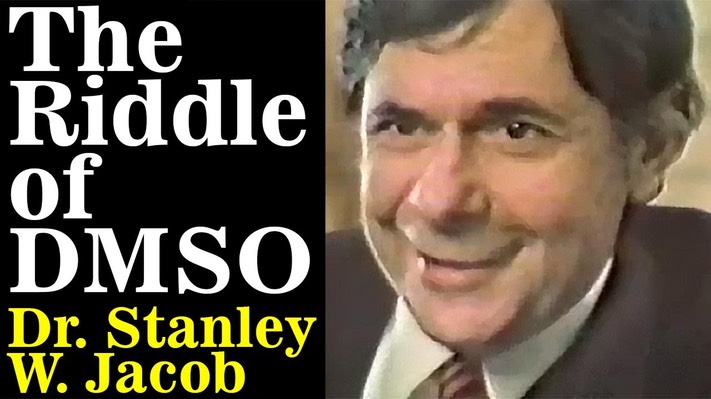
The Untapped Healing Potential of DMSO
July 2007
By Sue Kovach
Despite decades of research and thousands of studies attesting to its health-promoting properties, dimethyl sulfoxide (DMSO) remains virtually unknown to the medical professional and the public.
This inexpensive compound demonstrates potent anti-inflammatory and analgesic properties, has been shown to relieve painful musculoskeletal and urinary conditions, and may even fight Alzheimer’s disease and cancer. Unfortunately, its widespread acceptance and use has been stymied by the FDA and their allies in the pharmaceutical industry.
For more than 40 years, Dr. Stanley Jacob has been battling the establishment over DMSO. In this article, Dr. Jacob reveals new data showing the potential of DMSO in treating brain trauma injuries that afflict more than 50,000 Americans each year.
DMSO: Extensively Researched, Criminally Ignored
Dimethyl sulfoxide (DMSO) is an anti-inflammatory and analgesic compound that holds promise in managing a wide range of debilitating health conditions. DMSO is an approved pharmacological agent in more than 125 countries, and its safety and therapeutic effects are backed by nearly 50 years of research and more than 10,000 scientific articles on its biological implications.
Unfortunately, the vast health-promoting potential of DMSO has gone unfulfilled in America, suppressed by a combination of bureaucratic ineptitude and pharmaceutical industry lobbying. In the United States today, DMSO is approved to treat only one medical condition: interstitial cystitis, or chronic inflammation of the bladder wall. Recent findings on DMSO’s ability to help manage the effects of head injury have renewed interest in the many potential therapeutic applications of this versatile compound.
Treating Head Trauma
Traumatic brain injury is the most common injury of soldiers returning from the war in Iraq. In light of this, new clinical trials using DMSO to manage the elevated intracranial pressure common to such injuries are now being approved.

At the forefront of this work is Stanley Jacob, MD, a pioneering DMSO researcher and member of the Life Extension Foundation’s Scientific Advisory Board. Having conducted research on DMSO and its many medical uses since the early 1960s, Dr. Jacob is often called “the father of DMSO” in honor of his life’s work in trying to bring this unique compound to the forefront of contemporary medicine. His resolve in the face of government and drug industry obstacles is legendary. A faculty member at the Oregon Health and Science University in Portland, Dr. Jacob maintains that DMSO can be an effective treatment for closed head trauma and holds promise for other conditions such as spinal cord injuries and embolic stroke.
“Closed head trauma is severe trauma from a blunt injury, where the head hasn’t been opened,” he explains. “It’s the type of injury that could occur in a car accident, such as a severe concussion causing unconsciousness. With this type of injury, the brain swells against the hard bone of the skull, causing brain cells to die. It also diminishes blood supply and oxygenation, and causes a major shift in electrolytes within the brain. To treat these conditions, DMSO is administered intravenously as soon as possible after the injury occurs.”
According to Dr. Jacob, “DMSO is a potent free-radical scavenger and diuretic that reduces swelling and improves blood supply to the brain. This improves blood oxygenation to brain tissue. Injured brain cells often aren’t dead. When these cells get increased blood supply and more oxygen, and when the free radicals are scavenged, dying cells can recover, and brain swelling is reduced very rapidly.”
Dr. Jacob notes that in studies conducted from 1978 to 1982, “we observed that when the human brain was treated with intravenously administered DMSO after a head injury, the swelling could be reduced within five minutes. No other treatment comes close to acting that quickly. In patients given other commonly used therapeutic agents such as intravenous barbiturates, the brain continued to swell. We’ve known about DMSO’s efficacy for this type of injury for a long time.”
Astonishingly, however, the Food and Drug Administration (FDA) has not approved any new pharmacological agent of significance for the treatment of traumatic brain injury in more than three decades. With so much attention focused on the plight of severely injured soldiers returning home from war, Dr. Jacob is leading the charge to gain FDA approval of DMSO to treat this type of injury. He believes that DMSO would be more effective than some current therapies such as removing parts of the brain to reduce swelling.
“In my opinion, DMSO has the potential to be the pharmacologic treatment of choice for traumatic brain injuries from combat,” says Dr. Jacob. “There’s nothing that comes close to it in efficacy.”
Dr. Stanley Jacob currently serves as the Chairman of Abela Pharmaceuticals, Inc. Based in Orange County, California, Abela Pharmaceuticals was formed in 2005 for the purpose of developing and clinically testing DMSO and DMSO-related products. The company’s mission is to bring DMSO to market for the treatment of injuries and conditions affecting the central nervous system, including traumatic brain injury, stroke, and Alzheimer’s disease.
Dr. Jacob and his colleagues previously sponsored preliminary clinical trials of DMSO on traumatic brain injury patients in Europe. The results of the trial were remarkable, with an 80% survival rate (about twice the historical rate of 30-40%) and 70% of the patients experiencing a favorable outcome (far higher than the historical rate of less than 10%).1
Based primarily on these results, the FDA has given Abela’s Investigational New Drug application “fast track” designation and will allow the company to clinically test DMSO on traumatic brain injury patients. The controlled, multi-center study is equivalent to a Phase 2b trial, and is expected to begin later this year.
Accidental Discovery of DMSO
DMSO has a long list of primary pharmacological actions, including fighting inflammation, relieving pain, improving blood supply, scavenging free radicals, softening scar tissue, and effects that may benefit autoimmune conditions.2 So why is a treatment shown in decades of studies to be safe and effective for so many conditions not approved for more than one medical use? The answer may lie in DMSO’s long, controversial history, which includes the many years Dr. Jacob has spent researching and fighting for its approval.
A simple compound once described as a cheap industrial solvent, DMSO is in fact a byproduct of the paper manufacturing process, and was first isolated in the mid-1800s by a Russian chemist. In the early 1960s, when one paper manufacturing company in the Pacific Northwest decided to explore DMSO’s possible commercial uses, its fascinating medical potential began to emerge.
Washington state-based Crown Zellerbach Corporation asked one of its staff chemists, Dr. Robert Herschler, PhD, to investigate other potential uses for DMSO. Dr. Herschler observed that DMSO could penetrate the leaves of plants, and believed it might be useful in carrying nutrients and fungicides into diseased trees.3
Dr. Jacob, then assistant professor of surgery at the University of Oregon Medical School (later renamed the Oregon Health and Science University), learned of British research showing that DMSO acted like a medical “antifreeze” to protect blood cells frozen for storage. He was intrigued, as his major research interest was the preservation of organs for transplantation. Before coming to Oregon, Dr. Jacob was on the faculty of Harvard Medical School and had worked with Massachusetts Institute of Technology (MIT) researchers to develop an apparatus for freezing a kidney from the inside out by way of the kidney’s vasculature, thus avoiding a shell of ice encircling the kidney. In Oregon, Dr. Jacob saw DMSO as a potential chemical means of protecting organs from freezing. He contacted Crown Zellerbach and was introduced to Dr. Herschler, and the two teamed up to investigate DMSO’s medical potential.
Excellent presentation on uses, application, and benefits. Nov 2019
DMSO liquid - Dimethyl sulfoxide is one of the most amazing compounds with 40 odd pharmacological properties. This video is about what it is, DMSO benefits, it is natural health and I feel every household should have some in the cabinet. It is non-toxic and used as a preservative for stem cells, bone marrow, organs for transplant and human embryos. Amazing for pain relief and inflammation amongst other things. It can help with more than 300 ailments including burns, acne, arthritis treatment, strokes, head trauma, sprains, strains, toothache, headache, haemorrhoids, muscle strains, spinal cord injuries, softens scar tissue, fibromyalgia, interstitial cystitis, diabetes, congestive heart failure, cancer, aids, colds sores, it improves eyesight, macular degeneration, blocked sinuses, sinus infection (works great with colloidal silver), gum disease, tooth decay, varicose veins, cataracts - and the list goes on. Cheap to buy and easy to use, I feel every household should have it in the health toolbox.
DMSO A REAL MIRACLE CURE FOR CANCER AND OTHER AILMENT
DMSO has been kicked to the wayside for conventional drugs in the name of profit. This alternative cure is really inexpensive so the FDA and Big Pharma don't want you to know about DMSO. DMSO is fast and effective for many uses. it doesn't cure everything but can give great relief for many things.